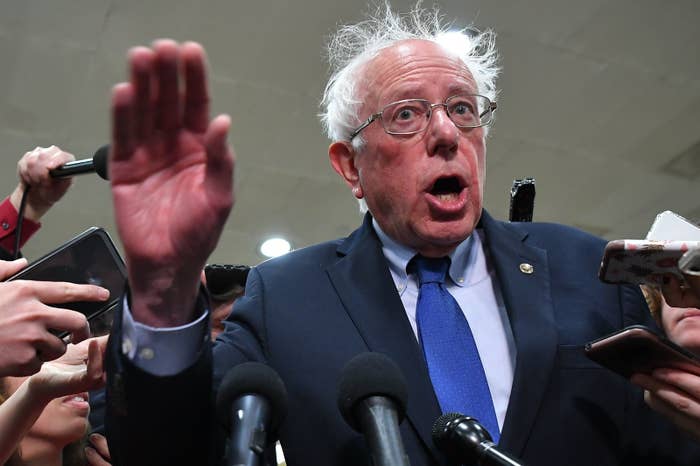
More than a dozen high-dollar contributions funded Bernie Sanders’ policy institute the year before he launched his second presidential bid, including one donation totaling $100,000, according to tax forms filed this month with the Internal Revenue Service.
The Sanders Institute, a progressive think tank founded in 2017 by the Vermont senator’s wife, Jane Sanders, raised more than $361,000 last year from a total of 13 large contributions ranging from $5,000 to $100,000, the tax filing shows.
The institute's executive director, Jane Sanders’ son from a previous marriage, Dave Driscoll, provided a copy of the filing, which is subject to public inspection, and said that most of the high-dollar contributions came from organizations or family foundations and grants. Bernie and Jane Sanders also provided some of that funding, Driscoll said.
Driscoll identified some of the contributors as the National Nurses United, a progressive network of nurses that helped fund Sanders’ 2016 campaign; Our Revolution, the political nonprofit Sanders founded after the primary; and Healthy Housing Foundation, a nonprofit branch of the AIDS Healthcare Foundation focused on providing housing for people with low incomes. The Sanders Institute listed National Nurses United, Our Revolution, and Healthy Housing Foundation as the three partners of the institute’s 2018 gathering.
Driscoll declined to disclose further details, or identify the source of each contribution.
The group is in the process of suspending operations this month to avoid any possible financial conflicts of interest while Sanders competes for the Democratic nomination.
Sanders, the 77-year-old independent and self-described democratic socialist, has made small-dollar, online fundraising a staple of his national political career. Throughout 2016, he proudly reminded supporters that the average donation to his campaign totaled $27, while he criticized his opponent, Hillary Clinton, for delivering paid speeches to Wall Street groups and raising millions for her family’s Clinton Foundation.
Sanders remains an enemy of Wall Street Democrats, many of whom funded Clinton in the 2016 election. Still, that campaign made Sanders a national celebrity and progressive icon, generating enough interest and financial support after the end of the Democratic primary for the senator and his wife to launch the institute and his political group, Our Revolution, which seeks to elevate progressive candidates and causes and is now working to bolster Sanders’ case to voters in the industrial Midwest.
The Sanders Institute’s fundraising activity and operating expenses pale in comparison to those of the Clinton Foundation, which raised millions, including from foreign governments, over some 15 years to support dozens of programs, housed across 11 central “initiatives,” ranging from efforts to help cashew farmers in India; train fisherfolk in Colombia; and provide vaccines in Kenya, Ethiopia, and Malawi.
In addition to a research fellowship program and online activity, the Sanders Institute’s work revolved largely around a policy summit in Burlington, Vermont, in late November 2018 — held weeks after Sanders’ reelection to the US Senate and months before he jumped in the 2020 race. The gathering — which drew progressive icons (activist Cornel West), celebrities (actor John Cusack), and foreign leaders (Brazil’s Fernando Haddad) — cost nearly $416,000. (It raised the institute about $145,000, the filing shows.)
The IRS disclosure, a 2018 Form 990 provided upon request by the Sanders Institute, shows that the group’s costs were covered in large part by the small group of contributors. The filing lists the amount, but not the source, of each contribution.
According to the Form 990, the contributions included one for $100,000; three for about $50,000; one for $35,000; and another for $30,000. There were two more contributions for $10,000 each and another five for $5,000.
The Sanders Institute formally launched in 2017 with a personal donation of at least $25,000 from Bernie and Jane Sanders, as well as $190,000 in seed money from Our Revolution, according to a VTDigger report published last year. (The group’s last IRS filing shows $459,000 in 2017 contributions but does not detail the source of the funds.)
Sanders, now three months into his second presidential bid, still touts the power of a grassroots movement driven by small donors. A reminder of the theme — “Not me. Us.” — is printed on thousands of bumper stickers and remains a recurring line at his rallies.
On Wednesday morning, Sanders campaign officials told Politico they would begin holding “grassroots fundraisers” in an effort to raise more than the average $16 or so donation they generate online and compete with a well-funded frontrunner, former vice president Joe Biden. The events will be ticketed and could attract high-dollar donors.
The Sanders campaign did not respond to a request for comment.
